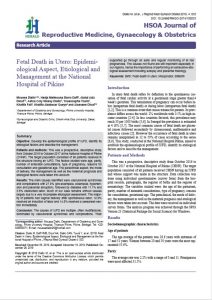
Objective
Develop the epidemiological profile of IUFD, identify its etiological factors and describe the management.
Patients and methods
This was a prospective, descriptive study from October 2016 to October 2017 at the National Hospital of Pikine (CHNP). The target population consisted of all patients received in the structure having an IUFD. The factors studied were age, parity, number of antenatal consultations, type of pregnancy, reasons for consultation and gestational age. The paraclinical aspect, the mode of delivery, the management as well as the maternal prognosis and etiological factors were taken into account.
Results
The main causes identified were vasculorenal syndromes and complications with 27.9% (pre-eclampsia, eclampsia, hypertension and placental abruption), followed by diabetes with 11.1% and 5.6% obstructed labor. Much of our case remains without causes largely due to a very incomplete etiological assessment. The majority of patients had vaginal delivery after spontaneous labor, 12.9% received an induction of labor and 14.8% received a caesarean section immediately.
Conclusion
The causes of IUFD are multiple, often multifactorial, dominated by vasculorenal syndromes and complications. Their supported go through an early and regular monitoring of at risk pregnancies. The causes not found are still important especially in our regions, hence the importance of performing an exhaustive etiological assessment including autopsy and placental histology.